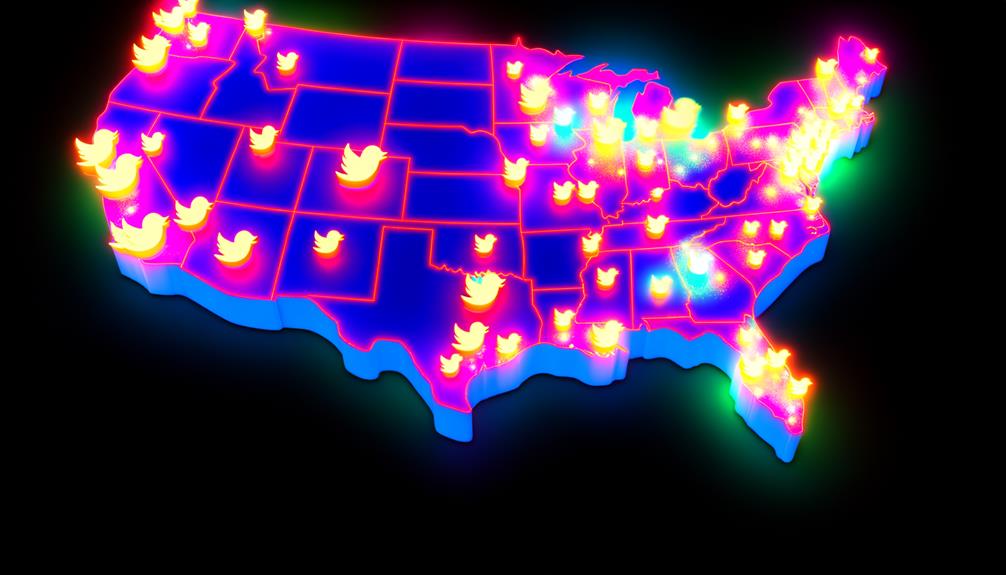While some may say that all of life’s mysteries can be solved by observing the trending hashtags on Twitter, you might have a bit more skeptical view. Still, it’s undeniable that Twitter trends in the U.S. offer a real-time snapshot of the national pulse – what has us laughing, crying, or furrowing our brows in confusion.
It’s like a collective consciousness, a shared experience in 280 characters or less. But what’s behind these trends, and more importantly, what’s their real impact? I’m sure you’re intrigued to find out more.
Understanding Twitter trends
To fully grasp Twitter’s trending topics, it’s crucial to understand how these trends are determined and what they represent. When you tweet, Twitter’s algorithm takes into account several factors to decide if your tweet is significant enough to become a trend. It’s not just about the volume of tweets. The speed at which a topic is being tweeted about, the location of the tweeters, and even the time of day can play a part.
Twitter trends represent the pulse of public sentiment. They’re real-time indicators of what’s important to people right now. You can think of them as a snapshot of collective consciousness. Sometimes they’re serious, reflecting global events or political movements. Other times they’re lighthearted, capturing the latest pop culture fad or internet meme.
Interpreting these trends, however, isn’t always straightforward. They’re a mix of hashtags, keywords, and phrases, and they can be influenced by bots or organized campaigns. So, understanding Twitter trends requires a bit of savvy. It’s about more than just reading the words – it’s about understanding the context behind them. Remember, the world of Twitter trends is fleeting, and what’s trending now mightn’t be in the next hour.
Evolution of hashtag phenomenon
You’ve seen them, used them, and now it’s time to understand them: hashtags, the cultural phenomenon that has revolutionized how we categorize and discover content on Twitter.
Hashtags first appeared on Twitter in 2007, a brainchild of a user named Chris Messina. Wanting a way to group related tweets, he suggested using the pound symbol followed by a keyword. Twitter initially dismissed the idea, but users quickly adopted it. The first widely used hashtag was #sandiegofire, helping consolidate updates about wildfires in California.
Over the years, hashtags evolved from simple categorization tools to powerful drivers of social movements and marketing campaigns. They’ve become a digital rallying cry, like #BlackLivesMatter, or a catchy tagline for brands, like Coca-Cola’s #ShareACoke.
Twitter’s algorithm now prioritizes posts with popular hashtags, creating a snowball effect; the more a hashtag is used, the more visible it becomes. Consequently, tweets with trending hashtags get more engagement, encouraging users to jump on the bandwagon.
Impact of Twitter trends on society
While hashtags may seem like simple digital markers, they’ve had a profound impact on society, shaping conversations and even influencing real-world events. They’re like a pulse, reflecting the heartbeat of a nation. One tweet can spark a movement, drive change, or even alter the course of history.
Imagine you’re scrolling through your Twitter feed and notice a trending hashtag. It’s more than just a popular topic; it’s a reflection of what’s capturing the nation’s attention. It could be a political movement, a celebrity scandal, or a natural disaster. You’re not just observing it, but you’re also part of it.
Twitter trends can amplify your voice, making it heard in corners of the world you couldn’t reach otherwise. They’ve democratized information, breaking down barriers between you and the rest of the world. You can connect with like-minded individuals, engage in dialogue, or join a cause you believe in.
But it’s not all positive. Misinformation can spread quickly, causing panic or harm. You’ve got to be mindful of the information you share and engage with. Remember, with great power comes great responsibility. Twitter trends are a tool at your disposal, use them wisely.
Case study: Viral trends analysis
Let’s examine a specific example to better understand how Twitter trends become viral and their consequential societal effects. You probably recall the viral ‘Ice Bucket Challenge’ trend that swept across Twitter in 2014. People worldwide were dumping buckets of ice-cold water over their heads, posting the video on Twitter, and challenging others to do the same or donate to the ALS Association. This trend went viral because it was engaging, fun, and for a good cause.
The societal effects were profound. The ALS Association reported that they received $115 million in donations during the summer of 2014 alone. This funding led to significant advancements in ALS research and support for those affected by the disease.
Now, you may wonder how this trend started. It’s simple: one tweet can spark a trend. Pete Frates, a former Boston College baseball player diagnosed with ALS, tweeted his ice bucket challenge, and the trend took off from there. This case study illustrates how Twitter trends can spread like wildfire, engaging millions and creating meaningful societal impact.
Leveraging trends for business growth
Understanding and leveraging Twitter trends can significantly boost your business growth, reaching new audiences and increasing brand visibility. When a topic begins trending, it means people are talking about it right now. If you’re smart about it, you can use this to your advantage.
You’ve got to stay alert, keep an eye on what’s trending, and when you spot a trend that aligns with your brand, jump in. But remember, it’s not just about tweeting anything. Your content must provide value. It could be an insightful comment, a funny meme, or an informative blog post. Whatever it is, ensure it’s something your audience will appreciate.
Be careful not to force a connection with a trend. Your audiences are savvy and can spot a forced tie-in a mile away, which may harm your brand’s reputation. Instead, ensure your participation in the trend feels organic and authentic.
Leveraging trends isn’t merely about gaining visibility; it’s also about demonstrating that your brand is up-to-date and engaged with the world. It’s a method of showing your customers that you’re in touch with what matters to them, and that’s a powerful tool for business growth.
Conclusion
So, you’ve seen the pulse of the nation through Twitter trends. They’ve evolved from simple hashtags into powerful societal tools. Their impact on society and business is undeniable. By understanding these trends and their effects, whether it’s a viral sensation or a business opportunity, you’re now equipped to harness Twitter’s dynamic platform to its fullest.
Get out there and make your voice heard, ride the trend wave, and potentially see your impact grow.










